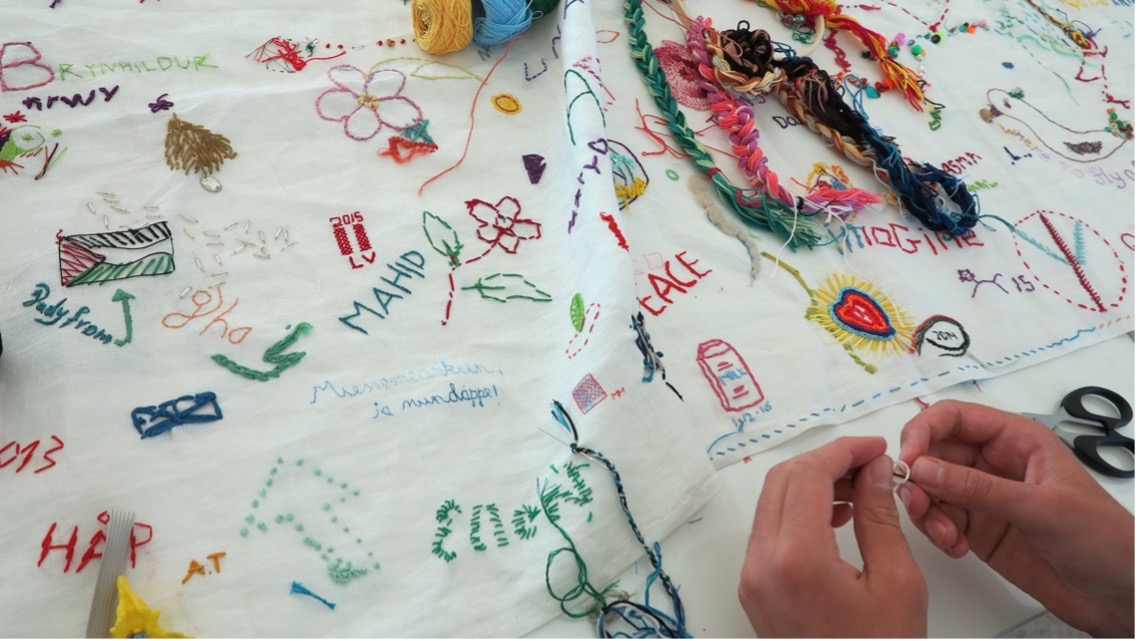The stitch project
Traces of diapraxis and al masha within participatory textile projects
DOI:
https://doi.org/10.7577/ar.5796Emneord (Nøkkelord):
participatory art, embroidery, textile, al masha, diapraxisSammendrag
In this article, I shall discuss participation – the artist's role and responsibility in participation, and the potentials of participatory textile projects in the public space. In doing so, I will focus on The stitch project (2012–). This project involves public interaction through acts of tactile textile making such as stitching on a tablecloth. I have based this study within a context of understanding matter and the embodiment of participation from feminist (Ahmed, 2006; Butler, 1988) and new materialist (Barad, 2003; Coole & Frost, 2010; Garber, 2019) perspectives. I am interested in the interactive aspects of The stitch project and how these aspects relate to the concepts of diapraxis (Nunes, 2019) and al masha (Hilal & Petti, 2018). In regard to these terms, I aim to examine the potentials and challenges of participatory textile art projects, like The stitch project, by examining their social and material aspects as well as the complexities of inclusion and participation.
Referanser
Ahmed, S. (2006). Queer phenomenology: orientations, objects, others. Durham: Duke University Press.
https://doi.org/10.1515/9780822388074
Ahmed, S. (2019). What's the Use? On the Uses of Use. Durham, London: Duke University Press.
https://doi.org/10.1215/9781478007210
Almaany (n.d.) مشاع . Retrieved October 29 from https://www.almaany.com/en/dict/ar-en/مشاع/
Barad, K. (2003). Posthumanist Performativity: Toward an Understanding of How Matter Comes to Matter. Signs, 28(3), 801-831.
https://doi.org/10.1086/345321
Barney, D., Coleman, G., Ross, C., Sterne, J., & Tembeck, T. (2016). The Participatory Condition. An Introduction. In D. Barney, G. Coleman, C. Ross, J. Sterne, & T. Tembeck (Eds.), The Participatory Condition in the Digital Age (pp. vii-xl). Minneapolis: University of Minnesota Press.
Bhabha, H. K. (1994). The location of culture. London: Routledge.
Bherer, L., Dufour, P., & Montambeault, F. (2016). The participatory democracy turn: an introduction. Journal of civil society, 12(3), 225-230.
https://doi.org/10.1080/17448689.2016.1216383
Boomgaard, J. a. R. B. e. (2017). Being Public: How Art Creates the Public (Making Public). Amsterdam: Valiz.
Braidotti, R. (2019). Posthuman knowledge. Medford, MA: Polity.
Bryan-Wilson, J. (2017). Fray: Art and Textile Politics. Chicago: University of Chicago Press.
https://doi.org/10.7208/chicago/9780226369822.001.0001
Burisch, N. (2016). From Objects to Actions and Back Again: The Politics of Dematerialized Craft and Performance Documentation. Textile, 14(1), 54-73.
https://doi.org/10.1080/14759756.2016.1142784
Butler, J. (1988). Performative Acts and Gender Constitution An Essay in Phenomenology and Feminist Theory. Theatre Journal, 40(4), 519.
https://doi.org/10.2307/3207893
Coole, D., & Frost, S. (2010). New materialisms: ontology, agency, and politics. Durham & London: Duke University Press.
https://doi.org/10.2307/j.ctv11cw2wk
Coumans, A. (2017). Art as Encounter. In J. B. R. Brom (Ed.), Being public: how art creates the public. Amsterdam: Valiz.
Deadman, R. (2018). Labour of Love, New Approaches to Palestinian Embroidery. In Palestine Museum (Ed.). Birzeit.
Finkelpearl, T. (2014). Participatory Art. In M. Kelly (Ed.), Encyclopedia of Aesthetics. New York: Oxford University Press.
Garber, E. (2019). Objects and New Materialisms: A Journey Across Making and Living With Objects. Studies in Art Education, 60(1), 7-21.
https://doi.org/10.1080/00393541.2018.1557454
Hilal, S., & Petti, A. (2018). Permanent temporariness. Stockholm: Art and Theory Publishing.
Kawar, W. K. (2011). Threads of Identity: Preserving Palestinian Costume and Heritage. Limassol, Cyprus: Rimal Publication.
Kwon, M. (2002). One place after another: site-specific art and locational identity. Cambridge, Mass: MIT Press.
https://doi.org/10.7551/mitpress/5138.001.0001
Merriam-Webster. (n.d.). Stitch. In Merriam-Webster.com dictionary. Retrieved November 17, 2019, from https://www.merriam-webster.com/dictionary/stitch
Mitchell, V. (2013). Dialog stitching with metonymy. Textile, 11(3), 314-319.
https://doi.org/10.2752/175183513x13793321037601
Nunes, D. F. (2019). The Power of Listening: Diapraxis, Play and Another Grammar for the City. Oslo Biennalen First Edition 2019 - 2024: New, Ongoing and Completed by October 2019. Kulturetaten Oslo kommune.
Weizman, E. (2010). Introduction. In M. Miessen (Ed.), The nightmare of participation: (crossbench practice as a mode of criticality) (pp. 9-12). New York: Sternberg.
Wiktionary (n.d.) Action. Retrieved November 17, 2019 from https://en.wiktionary.org/w/index.php?title=action&oldid=78207185

Nedlastinger
Publisert
Hvordan referere
Utgave
Seksjon
Lisens
Opphavsrett 2024 Marie Skeie

Dette verket er lisensiert under Creative Commons Attribution 4.0 International License.
Forfattere som publiserer med dette tidsskriftet må være enige i følgende vilkår:
a) Forfattere beholder opphavsrett, men gir tidsskriftet rett til første publikasjon med arbeidet, samtidig som artikkelen er lisensiert under en Creative Commons Attribution-lisens som tillater andre å dele arbeidet med en anerkjennelse og referanse til forfatterskap og første publikasjon i dette tidsskriftet.
b) Forfattere må ikke inngå separate, ytterligere kontraktsmessige ordninger for eksklusiv distribusjon av artikkelens publiserte versjon av arbeidet (for eksempel legge det til et institusjonelt arkiv eller publisere det i en fagbok), uten referanse en anerkjennelse av hvor artikkelen først ble publisert. Dette gjelder for eksempel artikler som publiseres i Nordisk Barnehageforskning og som senere blir del av et doktorgradsarbeid. Da er det viktig å ha tydelige referanser til hvor og når artikkelen er publisert første gang.
c). Forfattere kan ikke legge inn sine arbeid på nettet eller publisere dem i en doktoravhandling (for eksempel i institusjonelle arkiv eller på en hjemmeside) før eller under innsendings- og fagfellevurderingsprosessen, da dette kan skape uorden i referansesystemet til artikkelen.